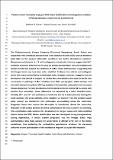Positive cerium anomalies imply pre-GOE redox stratification and manganese oxidation in Paleoproterozoic shallow marine environments
Abstract
The Paleoproterozoic Koegas Subgroup (Transvaal Supergroup, South Africa) was deposited in the immediate prelude to the Great Oxidation Event (GOE), and can therefore shed light on the oceanic paleoredox conditions just before atmospheric oxidation. Manganese enrichments of ∼16 wt% in diagenetic kutnahorite horizons suggest that Mn2+ oxidation occurred, either by free O2 or by an ancient photosystem. Iron and molybdenum isotope trends also support the existence of a Mn4+-oxide sediment flux, suggesting that the Koegas basin may have been redox stratified. Evidence from detrital and authigenic pyrite with mass-independently fractionated sulfur isotopes, however, suggests that the atmosphere was devoid of oxygen. To resolve this contradiction, this paper presents new constraints on pathways of Mn2+ oxidation from field, petrographic, stable isotope, and rare earth element and yttrium (REYSN) analysis of stromatolitic carbonates from the upper Koegas Subgroup. Ferroan dolostones and limestones preserve marine REYSN arrays with positive CeSN anomalies. These differences are explained by a redox stratified basin, whereby Mn2+ and Ce3+ are oxidized at a redoxcline and Ce is adsorped onto sinking Mn-oxide particles. Mn-oxide particles and a negative Ce anomaly from the oxidized upper water column are transferred into carbonates accumulating above the redoxcline. Diagenetic fluids later reduce the Mn-oxides to kutnahorite. Below the redoxcline, reduction of Mn-oxides particles enriches carbonates in Mn and a positive Ce anomaly. This contribution adds evidence for development of oxygen oases and redox-stratified basins before the GOE. Redox stratification was best developed during transgressions. During regressions, a deltaic system prograded into the Koegas Basin. High sedimentation rates likely allowed for preservation of detrital pyrite only in the deltaic sandstones, thus explaining the contradictory geochemical evidence. No previously unknown ancient photosystem of Mn oxidation is required to explain Mn oxidation.
Citation
Warke , M R , Strauss , H & Schröder , S 2020 , ' Positive cerium anomalies imply pre-GOE redox stratification and manganese oxidation in Paleoproterozoic shallow marine environments ' , Precambrian Research , vol. In press , 105767 . https://doi.org/10.1016/j.precamres.2020.105767
Publication
Precambrian Research
Status
Peer reviewed
ISSN
0301-9268Type
Journal article
Description
MRW was supported by a NERC-studentship through the University of Manchester (NEL501591/1) and by the REI Fund of the Geological Society of South Africa. SS was supported through a Strategy Grant of the Faculty of Engineering and Physical Sciences at the University of Manchester.Collections
Items in the St Andrews Research Repository are protected by copyright, with all rights reserved, unless otherwise indicated.

